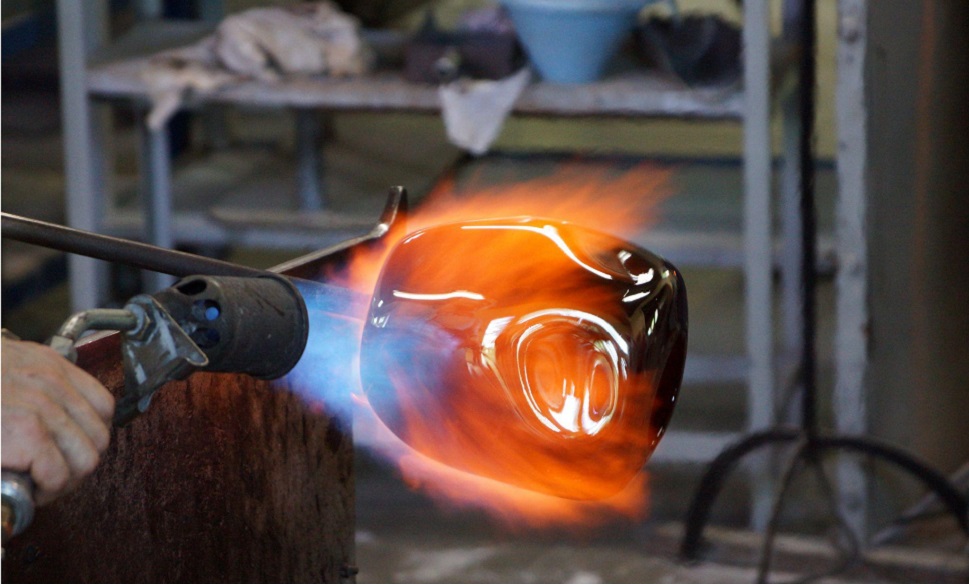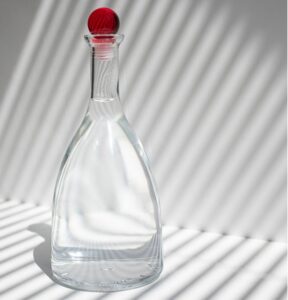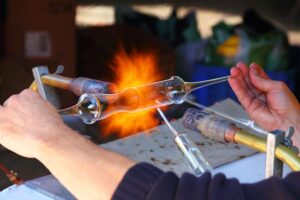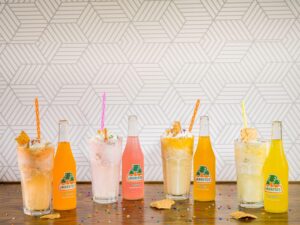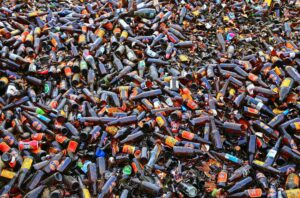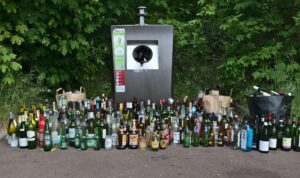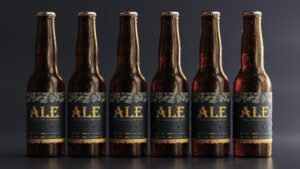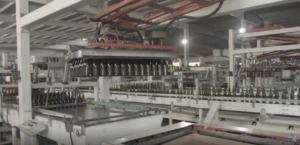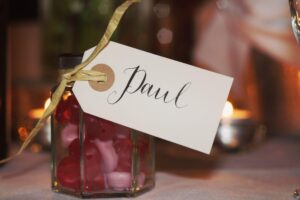We write this article to give guide on what is glass and glass bottle manufacure process, glass packaging and decorating.
When it comes to bottles that can be reused for water, glass rules the roost. For a number of different reasons, this is the method of storing food and beverages that are considered to be the most secure and optimal.
When opposed to plastic bottles and other choices, water stored in glass bottles retains its “purity of taste” since the water is unaffected by any flavor that may be present in the bottle itself. Glass may also bring about a sense of calm.
Bisphenol A (BPA) is a chemical that the Food and Drug Administration (FDA) began issuing warnings about in 2010 owing to its association with cancer.
Bisphenol A is present in a variety of plastics and even certain metal vessels. Glass water bottles are the healthiest option since they do not contain any chemicals, they are made of natural materials, and they can be cleaned in the dishwasher.
What is glass?
Glass is a substance that has the appearance of a solid but is really translucent, and it is utilized for a variety of purposes in our everyday life. Sand, soda ash, and limestone are the three primary raw materials used in the production of glass. These components are combined in the molten form at extremely high temperatures to produce the glass.
Glass, when heated to high temperatures, takes on the structural characteristics of liquids; when cooled to room temperature, however, it takes on the characteristics of solids. Because of this, the glass may be molded into a wide variety of forms by pouring, blowing, pressing, or molding it.
The production of glass has a long and storied history that stretches back to circa 3500 BC when it is thought that glass was first manufactured artificially in Egypt and Mesopotamia for the purpose of initially being used as jewelry and later on as vessels.
Since that time, there has been a consistent transition from manual labor to the high-tech industrial techniques that are used today. Additionally, the variety of glass varieties and uses has increased significantly. To find the best glass bottle manufacturers in China.
Composition of glass
It’s possible that when you hear the word “glass,” the first thing that comes to mind is a window or a drinking glass. There are, however, a great number of additional kinds of glass.
The term “glass” refers to an amorphous (non-crystalline) material that demonstrates a glass bottle closure to its melting point. Glass is a common household item. This is connected to the glass transition temperature, which is the temperature at which a crystalline solid becomes pliable as it approaches its melting point or a liquid becomes brittle as it approaches its freezing point.
Glass is a material in its own right. In certain contexts, the term “glass” refers only to inorganic compounds; nevertheless, in modern parlance, “glass” can also refer to an organic polymer or plastic, or even an aqueous solution.
Glass and Silicon Dioxide
The type of glass that is most common is known as silicate glass, and it is mostly made up of silica or silicon dioxide, written as SiO2. This is the kind of glass that is used for windows and many types of drinking glasses. Quartz is the shape that this mineral takes when it crystallizes. Glass is the term used to describe a substance that does not have a crystalline structure.
Sand containing silica may be melted down and used to manufacture glass. There are additional naturally occurring varieties of silicate glass. The color of the glass as well as its other characteristics are altered when impurities, as well as other elements and compounds, are introduced to the silicate.
What types of glass
Glass is capable of being produced with a variety of distinct physical qualities, making it suitable for a wide variety of applications. The applications range from complex industrial glass bottle design to straightforward household windows, and the number of uses is enormous.
Flat Glass
The float method of manufacturing glass results in the production of flat glass as the very first product. It is consistently thick and serves as the foundation for the production of more complex forms of glass through further processing. This kind of glass has a propensity to shatter into lengthy fragments and, after undergoing some further processing, is typically put to use in double glazing.
Facts About Flat Glass
This type of glass is used in the construction of a wide variety of everyday items, including automobile windshields, residential windows, bus shelters, electronic devices, household appliances, and many more.
Toughened Glass
The advantage of using toughened glass is that it is far less likely to break than regular glass. This makes it suitable for a variety of applications, such as shower doors, glass furniture, and shelving. The process of chilling toughened glass provides counteracting forces, which means that in the event that the glass does break, it will shatter into small, square fragments rather than shards, hence reducing the likelihood of an injury occurring.
Sandblasting the surface of glass gives it a translucent milky-white look, making it a common method used for shower doors and front doors when seclusion is necessary, but some light is also desired. Sandblasting gives the glass a milky-white appearance. This method can be carried out on a whole sheet of glass, or it can be used in conjunction with a mask that is resistant to sanding in order to produce patterned effects.
Toughened Glass Fact
It is believed that the French inventor Francois Barthelemy Alfred Royer de la Bastie was the one who first developed toughened glass, which he patented in the year 1874.
Patterned Glass
The production process for patterned glass often involves passing glass that has been heated through rollers that have a pattern that is intended to be imprinted into the glass. This kind of glass is frequently used for the windows or doors that are found in bathrooms. Similar to sandblasted glass, it allows some light to pass through but does not provide complete transparency. It is also used in custom glass bottles.
The Facts About Patterned Glass
In 1888, two brothers from Yorkshire named Chance pioneered the use of machine rolling as a method for the production of patterned glass.
Laminated Glass
In situations where a higher level of security may be required, such as for front doors, store window fronts, or automobile windscreens, laminated glass is a frequent choice that may be made. Because it is kept together by an interlayer, laminated glass will not shatter when it is subjected to an impact. As a result, the likelihood of break-ins and any risks produced by shards of shattered glass is reduced.
Laminated Glass Fact
Edouard Benedictus, a French scientist, accidentally created laminated glass after he knocked over a laboratory flask and saw that it did not shatter as a result of the remnant of nitrate cellulose that was left on the interior of the flask.
Mirrored Glass
Mirrored glass is a form of glass that is available with many other varieties of glass. Mirrored glass is not much more than a mirror, and it can be manufactured in any size imaginable, from little mirrors for bathrooms to full-length doors for wardrobes. A coating of metal, often silver, chrome, gold, or aluminum, is placed to one side of the glass during the manufacturing process, resulting in the creation of this material.
Mirrored Glass Fact
The very first mirrors consisted of either polished stone and metal, or water gathered in a vessel. They required no further components.
Coated Glass
Flat glass can be coated to make it more insulating and resistant to infra-red rays, for example. Coated glass is a type of glass that has had its flat surface changed. In order to increase the insulation of homes, it is frequently utilized for double-paned windows.
Facts Regarding Coated Glass
Increasing the thermal efficiency of your home and bringing down your monthly energy expenditures may be accomplished by applying a coating on the glass.
Tinted Glass
If you are concerned about maintaining your privacy, tinted glass is an excellent material choice for the doors and windows of your house or place of business. Even though it prevents others from looking in without permission, tinted glass lets in a significant amount of natural light and lessens the pain caused by the glare of the sun.
Tinted glass may also reduce the quantity of potentially dangerous ultraviolet light that passes through it, which is beneficial to the health of everyone in the household.
Tinted Glass Fact
Tinted glass is characterized by having a deeper color than regular glass due to the addition of trace quantities of metal oxides to the glass composition.
Sandblasted Glass
This alternative, which is also known as glass carving, strikes the ideal balance between beauty and discretion and is available. To produce the one-of-a-kind mist appearance seen on this glass, an abrasive substance is blasted into it under intense pressure. This frosted appearance may be utilized to safeguard the privacy of bathroom windows and shower doors, and it can also be shaped into sophisticated patterns to generate ornamental panes of glass that can enhance the look of your interior design.
Facts Regarding Sandblasted Glass
Sandblasted glass, also known as frosted glass, functions by scattering the light that travels through it, which results in the picture on the other side being more blurry. Buy any of these 500ml glass bottles wholesale.
Why people love glass
Glass has been, and continues to be, a popular category of material for people to work with for a broad variety of reasons. This is due to the fact that there are many different types of glass. In light of this, I would want to elaborate on a couple of these points a little bit further:
Unique Interactions
In today’s technological applications, we are able to connect with electronics by touching them or even gesturing through glass, and we can also transmit visuals via enormous billboard displays or projectors. When we’re looking at buildings, we often do it via picture windows or while climbing floating layers of glass steps. Glass may also be used in the preparation of food and beverages, the storage of liquids, and the cooking of food. To my knowledge, there is no other category of materials save glass that is capable of providing such a diverse array of one-of-a-kind interactions.
Integrity of the Structure
Glossy materials, most commonly glass, serve as the focal point for a variety of products or environments, such as windows, dividers, light fixtures, displays, and so on. These materials frequently perform exceptionally well beyond both the actual and the perceived expectations that are placed on them.
Glass typically possesses many functions, such as the ability to convey light, messaging, or imagery to people or spaces while simultaneously providing structural integrity or security to the entire product or fixture. Other uses for glass include these functions. In most situations, the benefits of employing glass outweigh its drawbacks, including the fact that it can be brittle in certain environments.
The Transmission of Light
Glass is quite unique in that it possesses properties such as transparency, translucency, and the capacity to be active (the ability to shift from one condition to another). Because of these qualities, designers now have the potential to send light, data, and graphics for a wide variety of communication applications or aesthetic effects.
The range of characteristics, effects, and applications that may be achieved with glass can be expanded by combining it with other materials or by stacking numerous layers of glass on top of one another. For instance, you may employ glass in the communications industry, in LED or OLED technology, in ceramics, or in fiber that gives static goods light effects or “alive.”
Variation in Both Its Texture and Its Finish
If you have the capacity to see through or into a material, you may create an almost limitless number of different visual effects. Some of them may include options for depth, gloss, reflection, textures, molded features, patterns, inlays, in-mold components, and so on. Other possible options include in-mold elements.
The use of high-quality glass coatings can provide the impression that a product is of premium quality or give the impression that it has extra value. Humans, like many other species who are drawn to shiny, brilliant, reflecting materials, frequently find that they are lured to the effects that glass has and the apparent worth that glass possesses.
Natural Magic
I feel that the enchantment of glass lies in the fact that it is translucent and mystical, creating a dance of light that can be seen and felt. In the past, glass production was difficult, and stained glass was seen as mystical, valuable, and respectful due to its rarity. Glass, because of its inherent ability to be recycled and reused, gives the impression of having a high value over the entirety of the product’s existence.
It’s possible that the fact that glass is the child of two of the fundamental components that humans have always venerated in nature, fire, and earth (or sand), is the reason why we have a stronger respect for glass things and a want to acquire them. The craft of designing with glass dates back to about the same time as the craft of designing with other materials.
However, after working with Corning engineers, scientists, inventors, and developers over the past few years, I believe that we are just beginning to see the opportunities that glass, ceramics, and a myriad of hybrid combinations will offer over the next several decades in the fields of technology, architecture, transportation, consumer goods, lighting, and communications, to name just a few of these fields. Glass is going to have a prosperous future, and I strongly believe that all designers and developers should learn more about glass so that they can figure out how to use it in their future creations.
Why recycling glass
The recycling of glass is a straightforward activity that makes a valuable contribution to the protection of our natural resources. Let’s take a look at some of the positive outcomes that can result from recycling glass.
Glass recycling is green
When discarded in a landfill, a glass bottle can take up to a million years to decompose into harmless substances. In comparison, it might take as little as thirty days for a recycled glass bottle to make its way from the recycling bin in your kitchen to a store shelf where it is displayed as a brand new glass container.
Recycling glass helps the environment
Glass containers are completely recyclable, which means that they may be recycled as many times as possible without the glass losing any of its original purity or quality. This is because glass can be recycled indefinitely.
Recycling glass is an effective use of resources
The recovered glass from the process of glass recycling is the basic component of all newly manufactured containers made of glass. One common type of container constructed of glass may include as much as seventy percent recycled glass. Estimates from the industry suggest that around eighty percent of all glass that is recycled will end up being used to make new glass containers.
Glass packaging
Glass is the packaging material that has been tried and tested to be the best for health, flavor, and the environment. It is also the only food packaging that is commonly used that has been given the classification of “GRAS” by the FDA, which stands for “generally recognized as safe” and is the highest level.
Glass containers have been used for the purpose of product packaging by people for hundreds of years. There is essentially no limit to the variety of things that may be packaged in glass, which includes everything from whiskey bottles to baby food. Glass, which has been around for such a long time as part of the human experience, frequently has an unusual influence on the person using it. Glass is frequently selected because of its smooth texture, non-porous characteristics, hand feel, weight, and visual appeal. This might be because glass is seen as having an air of luxury or a vintage style.
For instance, there is a new trend that is particularly popular among millennials of spending what some may perceive to be an excessive amount of money on elegant water bottles. This tendency is becoming more widespread. This specific trend achieves substantial sales potential when corporations are offering bottled water for $28 since it gives the impression of luxury or social standing (in glass).
The majority of food products, particularly liquids like soda, water, beer, and tea, are packaged in glass containers the vast majority of the time. Additionally, it is now commonly used for the packaging of things that legally include cannabis. And despite the fact that glass bottles used for these reasons are more expensive than their plastic equivalents, a significant number of businesses and customers choose glass containers.
Glass life cycle
During the course of its useful life, the product is utilized either for the purpose for which it was designed or, more likely, for a function that was not designed.
Products that are constructed using materials that are more durable will have a longer usable life, which will result in a reduction in the amount of total energy and resources that are required to replace the products.
A product has reached its end-of-life stage when it can no longer fulfill its intended purpose. At this point, it is discarded as waste. There are several different disposal alternatives available for empty glass bottles. One method involves sorting broken glass by color, then cleaning and crushing each color of glass separately due to the fact that each color of the glass is produced by adding a slightly different substance during the manufacturing process.
Following this step, the various shards of glass can be remelted and put to use in the production of other glass goods of the same hue, such as amber jars or green bottles. One of the benefits of recycling glass is that it allows for glass to be created with a lower melting point than that of raw ingredients. The subsequent phase of production may benefit from these energy savings.
Glass bottle shape size and color
Following are some of the glass bottle shapes, sizes, and colors:
Boston Round Bottles
Boston Round Bottles can be used for liquids, product storage, and field or plant sampling. Round in shape, with rounded shoulders and a thin screw neck opening, they have a distinctive look. These ecologically friendly bottles assist to reduce waste and ensure the integrity of the product for long-term storage. Clear / Flint Boston Round Bottles are ideal for samples that need to be clearly seen and preserved. For light-sensitive items, Amber & Cobalt Blue Boston Round Bottles are excellent.
French Square Bottles
For best content visibility, clear/flint French Square Bottles are ideal. Design features that maximize shelf and storage space are included. Mixing, storage, and sampling are all made easier by the largemouth.
Graduated Medium Round Bottles
Bio and pathological specimens can be stored in Bottle Beakers, also known as Graduated Medium Rounds, which can also be used to store industrial laboratory chemicals and reagents. To make pouring and handling easier, these clear / flint bottles have a little shoulder. Metric units of measurement such as milliliters and fluid ounces are used to grade the samples. The same container can be used for both mixing and measuring.
Media Bottles
PYREXborosilicate glass is used to make Media Bottles, which may be used for a variety of purposes, including storage, mixing, and sampling. Graduation lines and marking spots are permanently embedded in the white enamel of standard media bottles. With a PVC covering, PYREXPlus Media Bottles assist to prevent the glass from breaking and minimize spillage. Graduations and a parking space in the shade of teal enamel.
Oil Sample Bottles
Bottles with a #6 cork and an eye-catching appearance are included in the Clear/Flint Oil Sample Set. In the oil and gas business, transparent bottles like these are useful for conducting field tests. This bottle’s aesthetics make it a great container for showcasing product samples.
Square Tablet Bottles
With Flint Square Tablet Bottles, you can clearly see what’s within at all times. Benchtops with little storage space benefit from the compact shape of square glass bottles. Using these wide-mouth bottles, you can easily mix, store, and sample your products.
Standard Wide Mouth Bottles
Standard Large Mouth Bottles from Clear / Flint come with a wide aperture, making them excellent for a variety of applications. Applications range from pharmaceuticals and chemicals to food preservation.
Wide Mouth Packer Bottles
Broad mouth Amber Wide Mouth Packer Bottles are perfect for sampling solid products since they have a wide mouth. There is a wide range of uses, from pharmacological to chemical to environmental. Suitable for light-sensitive items.
How to manufacture glass bottles
At a glass container plant, the glass bottle production process is broken down into several stages. First, the glass is melted and blown into a bottle form, and then the new bottle may be given an interior treatment. An annealing process can then be applied. Cold end techniques are used to examine and package them after they’ve been finished manufacturing.
Hot End Activities
The glass bottle manufacturing process begins with hot end procedures, which often use a lot of heat to make and shape a glass container. Molding molten glass in a furnace is the first step in the manufacturing process. The vast majority of glass products are made using soda-lime glass stock, which is composed primarily of silica, with about 10% each of calcium oxide and lime. About 5% of soda-lime glass also contains trace quantities of aluminum oxide, ferric oxide, barium oxide, sulfur trioxide, and magnesia. This recycled glass is added to the stock before melting and accounts for anywhere from 15% to 50% of the final composition of the glass.
Glass Molding by Press-and-Blow
Individual section (IS) machines are used to do press-and-blow formation, which is the procedure most typically seen in the manufacturing of glass containers. IS machines include between five and 20 identical pieces, each of which may concurrently and entirely produce a glass container. The end result is that a single machine may create five to 20 containers at a time.
Between 1050 and 1200 degrees Celsius, glass is considered to be in its plastic phase, which is when press-and-blow formation takes place. Cutting and shaping the glass into a gob is done with a shearing blade. Gravitational force helps the sliced gob fall and roll through the correct duct to reach the molds.
Blow-and-Blow
A gob is released during the plastic stage and carried along to the molds in an IS machine, much like in press-and-and-blow formation. The blow-and-blow formation, on the other hand, utilizes compressed air to shove the gob into the blank mold. In order to create the container’s interior, the parison gob is flipped into a similar final mold and blown a second time. The blow-and-blow method may be used to create glass bottles with different neck thicknesses.
Glass Bottle Annealing
Once the creation process is complete, the uneven cooling speeds in certain bottles may cause stress. Glass containers can be reheated and cooled in an annealing oven, also known as a lehr, to alleviate tension and strengthen the bottle.
Cold End Processes
Bottles and other glass containers are examined and packed at this point in the process of making glass. To assure the quality of the finished product, automated and mechanical inspections are frequently used. There are several common defects to look for, such as cracks in the glass or stones in the furnace that melt off and end up in the finished container. These problems should be caught early on to avoid further damage. Depending on the type of bottle and the quantity of the manufacturing run, packaging methods differ from factory to factory. You can look for the empty glass bottle manufactures near me.
How to dispose glass bottles
Following are three ways to dispose of glass bottles.
- Clear, brown, and green glass bottles may all be recycled. From clear to brown to green, glass bottles are available in a wide range of hues. Bottles constructed of sand, soda ash, and limestone are the most common. Wine and beer are typically served in brown and green glass bottles. There is no difference between clear, brown, or green glass bottles when it comes to recycling.
- Check to see if the glass bottles contained solely food or drink. Recycled food-storage glass bottles are made of ingredients that can be used to produce new glass bottles, therefore most of them can be recycled. Beer and wine bottles made of glass may typically be recycled.
- Heat-resistant glass bottles should not be recycled. It is not possible to recycle Pyrex glass, such as bowls or cups, because they are built to withstand high temperatures. Instead of sending them to the landfill, consider donating or reusing them.
How to paint glass bottles
When you paint glass bottles, you’re not just reusing them, but also beautify your house. You may use painted glass bottles for a variety of celebratory events or as eye-catching decor in your home. Additionally, you may select from a wide variety of materials and ways to express your individuality and flair. You’ll be painting glass like a pro in no time if you have so many great ideas to select from.
- Take off the stickers. Submerging them in hot water and letting them soak for at least an hour is the most effective method. Once they’ve been soaked, they should come right off.
- The bottles should be properly dried. Make sure the bottle’s surface is absolutely free of imperfections. Scrape off any remaining glue with a utility knife if necessary.
- Draw patterns and designs on the interior of the bottle to make it more appealing to the eye. Foam stickers may be used to cut basic patterns for imprinting on the bottle. Ideal are forms or characters that are not too complicated. Remember to cut your letters backward if you’re utilizing them in your design.
- Spray the bottle’s exterior with the first layer of paint. Make sure your Olive oil bottle wholesale are standing properly on a flat surface, such as a piece of cardboard or linen before you start painting.
- Your bottles should be dried out. The drying time might vary based on the brand and type of paint, so always check the label. To ensure that the paint has a chance to properly set before handling or moving the bottles, let them dry overnight.
How to label glass bottles
In order to create labels that are simple to read and won’t peel or scratch off when washed, follow our instructions.
Look for a Font
You should look for a typeface that is both visually appealing and easy to read. Using an inkjet printer and a computer, print the ingredients on copy paper. The size of your jars or canisters should be taken into consideration when deciding on the font size for your labels. Using a pair of scissors, remove the printed ingredient names.
Center the Label
Using painter’s tape, attach a label with the name of an ingredient to the glass container.
Get Rid of Any Spills
Clean and dry the jar’s surface with isopropyl alcohol. The paint will stick better if the surface is pristine.
Make a Label by Using Paint and a Brush
Paint over the paper lettering taped inside the jar with a fine-tipped paintbrush brush dipped in ceramic paint. Take your time and be patient. If you make a mistake, mineral spirits and a clean fine-tipped art brush will help you eliminate the errant mark.
Repaint as necessary
Get rid of the paper and the painter’s tape within the jar. The paper will reveal any paint flaws, such as holes or thin patches, that were previously hidden beneath the surface. Apply extra paint to these places with the help of an art brush.
Clean and bake
Use unscented mineral spirits to clean your brushes once you’ve completed painting the labels. Overnight, let the jars dry out. A pre-heated 325° oven can be used to bake the jars for 40 minutes (or follow the manufacturer’s directions on your ceramic paint).
How to reuse glass bottles
Glass can be melted and reused indefinitely since it has an infinite life span. Instead of throwing away your used bottles and jars, consider finding new uses for them around your house. Continue reading to discover creative and entertaining methods to recycle glass bottles and jars of all sizes and shapes.
DIY Liquid Soap Dispenser
Soap dispensers may be made from any bottle that has a pump that will fit, so long as the pump is available. This easy-to-build dispenser would make a thoughtful birthday or housewarming present for anybody. You can also do glass bottle printing.
Wine Bottle Bird Feeder
Anyone with a little DIY know-how can make this bird feeder out of an old wine bottle, some wood, a few screws, and a length of wire rope. To refill the bottle, untie the rope and draw it out of the bottle. The seeds will filter out over time.
Glass Spray Bottle
Cleaning supplies can be stored in empty glass bottles. Just swap out the old plastic bottle’s spray nozzle for a glass one. Even while spray bottles come in useful for a variety of domestic tasks, the plastic they’re made of is porous and can leach dangerous chemicals into the contents. This is good news for people who want to use spray nozzles on glass bottles of vinegar and other liquids that come with twist-off tops.
Glass bottle decorations
If you’re looking for ideas on how to repurpose old glass bottles into home décor, tiny planter holders, lighting, outdoor decor, and more! Some of these items would be wonderful as presents, too!
Make a stunning glass bottle tree for your yard
When the sun shines through this DIY bottle tree, it appears like a work of art! Use cedar or redwood 44 posts with 8′′ long nails or rebars that are rot-resistant.
Hanging mason jar lights
Decorate your farmhouse and home for the holidays with these gorgeous mason jar ideas!
Recyclable glass bottle tiki torch
The wine bottle tiki torch you can make at home is a great addition to any outdoor celebration!
Recycled glass bottle edging for gardens
DIY yard décor that’s both fun and enchanting! You can also look for custom glass bottle manufacturers.
Conclusion
MC Glass is ready to develop design manufacture and ship qualified glass bottles on your demands. Clients can get benifits sourcing wholesale glass bottles from bottle China factory on cost-effective unit price and fast logistics management.
Looking for glass bottles China manufacturer? Contact now to get a free quote today!

